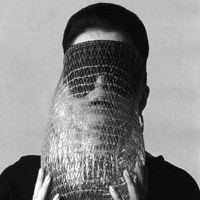Belo Horizonte, 1920 – Rio de Janeiro (Brasil), 1988
By Francisco Alambert
After beginning her art career with the architect and landscape designer Roberto Burle Marx in 1947, Lygia Clark went to Paris three years later to study with Léger, Dobrinsky, and Arpad Szènes, where she produced a series of drawings. In 1952, she held her first solo exhibition at the Institut Endoplastique in that city, and returned to Brazil, being awarded as a breakthrough artist at an exhibition at the Ministry of Education. In 1953, after some exhibitions, she won a prize at the National Abstract Art Exhibition with the work Composições. That same year, she participated in the II São Paulo Biennial, and the following year in the first exhibition of the Grupo Frente, a landmark in the organization of a new avant-garde in Brazilian visual arts.
Lygia was one of Brazil’s representatives at the Venice Biennale. In 1955, she participated in the III São Paulo Biennial and, in the same year, in the new exhibition of Grupo Frente at the Museum of Modern Art in Rio de Janeiro. The following year, she exhibited at the Itatiaia Country Club, where she presented Superfícies moduladas and Maquetes para interior, as well as at the I National Exhibition of Concrete Art in São Paulo. That same year, her works were included in the group exhibition Pintura Brasileña Contemporánea at the Uruguayan-Brazilian Cultural Institute. She was awarded at the IV and VI São Paulo Biennials and received a special room at that event in 1961. In 1959, the I Neoconcrete Exhibition was inaugurated at the Museum of Modern Art in Rio de Janeiro, when the Neoconcrete Manifesto, written by poet and art critic Ferreira Gullar, was also presented.
Also in 1959, she presented works at the exhibition Brazilianischer Künstler at the Haus der Kunst in Munich, and later one of her most striking creations, the series of sculptures called Bichos (1960), in which the observer is invited to interfere and create new forms. Two years later, these sculptures were exhibited at the Galleria d’Arte Della Casa do Brasil in Rome.
In 1963, she held her first solo exhibition in New York at the Alexander Gallery, and another at the Museum of Modern Art in Rio de Janeiro. She spent a season in Paris, participating in the exhibition L’Aujourd’hui de Demain at the Musée d’Arrais, with Jesús Rafael Soto, Sérgio Camargo, Vassarely, and Cruz-Diez in 1964. She also held a solo exhibition at the Studium Generale Technische Hochschule, organized by Max Bense, along with several others, until in 1965 a major solo exhibition of her works was inaugurated at the Signals Gallery in London, organized by Paul Keeler and Sérgio Camargo.
In 1966, she took her Matchbox Structures to the Opinião 66 exhibition and that same year presented works at the exhibition Art of Latin America since Independence, organized by Yale University Art Gallery and the University of Texas Art Museum. In 1967, she participated in the exhibition Nova Objetividade Brasileira at the Museum of Modern Art in Rio de Janeiro, also signing the Manifesto of the movement. In 1968, she achieved great success at the XXXIV Venice Biennale with a retrospective of her work. That same year, she returned to Paris, where she lived until 1977, engaging in various artistic events in Europe and the United States.
In 1972, Lygia Clark began teaching gestural communication at the Sorbonne, giving a new direction to her work, increasingly focused on the body and behavior. In 1975, she participated in the women artists’ exhibition Magma in Brescia, Italy. Back in Brazil, in 1980, she presented works at a show honoring critic Mário Pedrosa, who passed away shortly thereafter. In 1986, the Paço Imperial in Rio de Janeiro organized a major retrospective of her career. In 2004, her works were included in the exhibition Inverted Utopias: Avant-Garde Art in Latin America at the Museum of Fine Arts, Houston.




